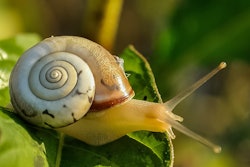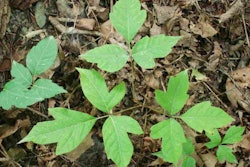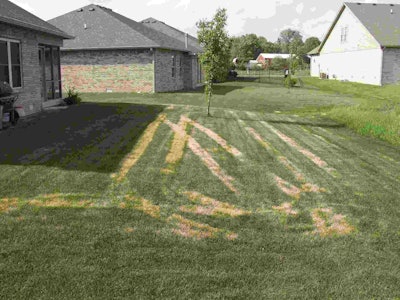 Turf damage can be done with mowers or ride-on sprayers as in this case, when the turf is under even mild turf stress.
Turf damage can be done with mowers or ride-on sprayers as in this case, when the turf is under even mild turf stress.Photo: Dr. Zac Reicher, Bayer
Set yourself up for success: If you wait until summer to start thinking about heat stress in cool-season lawns, it’s already too late. In a perfect world, you’d start making strides toward maximizing summer performance – or minimizing summer stress – months, or even years, ahead of the hot weather. And it really starts with two things: turf establishment and maximizing rooting in the spring.
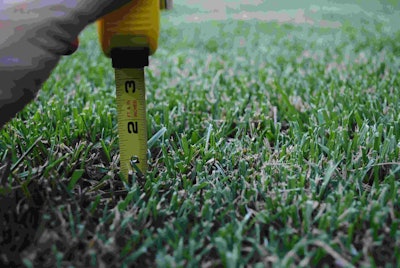 Mowing cool-season lawns at three inches or higher all season long will maximize rooting and summer performance.
Mowing cool-season lawns at three inches or higher all season long will maximize rooting and summer performance.Photo: Dr. Zac Reicher, Bayer
Turf establishment: Soil is the foundation of healthy turf. So, proper soil grading and preparation are fundamental in establishing health and resilience in a lawn.
Likewise, a good irrigation installation is going to help ensure that trouble areas are getting the water they need (or don’t need). And then, of course, the turf species itself is going to play into how well a lawn can pull through the summer. And overseeding/re-sodding when needed can help ensure you’ve got a strong canvas to work with come summer.
Maximize rooting in the spring: Most lawn care companies are doing these things already, but fertilization – primarily in the fall and late fall – is going to help a lawn be that much stronger when summer comes around.
Keep in mind, though, to limit spring and summer nitrogen for color and to maintain moderate growth. To help encourage rooting, you’ll also want to limit compaction through aerification and possibly decreasing traffic, if applicable.
Watering: Turf performs better when kept on the slightly dry side. In the summer, your customers may be tempted to overwater their lawns. You can help prevent that by offering your expertise in appropriate watering techniques.
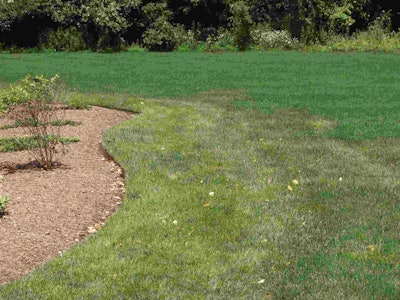 When mowing especially with ride-on mowers, alternate traffic patterns and avoid turning on turf to maximize turf health.
When mowing especially with ride-on mowers, alternate traffic patterns and avoid turning on turf to maximize turf health.Photo: Dr. Zac Reicher, Bayer
In the summer, roots are naturally going to shorten in the heat. When that happens, advise your customers to increase water frequency and decrease the duration of watering. You don’t want them setting their irrigation schedule in the spring and then forgetting about it all year.
Mowing: I’ll often hear about folks setting up for their first mow once it’s already hot – and ideally, that would have begun months ago. Encourage your customers to mow as tall as is feasible and practical, given their location.
The one-third rule is a good rule of thumb, meaning you wouldn’t want them to trim more than a third the height of the plant with any given mow. Encourage mowing in different directions and turn mowers on walks or drives to distribute wear. You can also advise them to avoid mowing during severe heat stress (though, admittedly, it can be tough to see).
Diseases: Summer patch and foliar diseases are the most common disease you’ll see crop up in the summer. For summer patch, control should have started in the spring when soil temperatures were about 60 degrees Fahrenheit at a 2” depth.
 White grubs can be controlled with summer applications of Merit, but the most effective control is achieved when applications are made at the high rate after the adults are seen in July and August.
White grubs can be controlled with summer applications of Merit, but the most effective control is achieved when applications are made at the high rate after the adults are seen in July and August.Photo: Dr. Zac Reicher, Bayer
DMI fungicides, like Armada, are typically your best bet and should be applied every 28 days. Foliar diseases like dollar spot and brown patch can usually be managed culturally in most lawns, but in tougher climates, a preventative control with a broad-spectrum fungicide like Armada on a 28-day schedule will be most effective.
Grubs: You’ll usually see grubs start to feed in mid-to late-summer. Merit has been a trusted solution for LCOs for decades, and applications should begin in July and August. Though most companies have inched the grub control applications earlier and earlier, time the first application for just after you see the adults of masked chafers or Japanese beetles – and use the highest label rate for optimal and most consistent control.
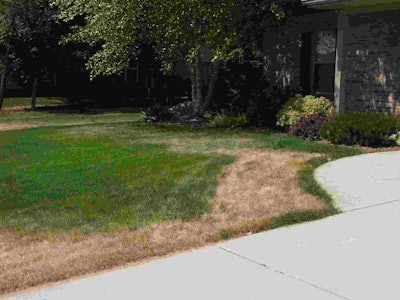 Herbicide applications during summer heat can cause turf damage, so minimize applications in high heat to only those that are absolutely needed.
Herbicide applications during summer heat can cause turf damage, so minimize applications in high heat to only those that are absolutely needed.Photo: Dr. Zac Reicher, Bayer
Weeds: Herbicides can cause turf to burn when applied in very warm temperatures. Most lawn care companies are cautious in this area already, but it’s an important reminder nonetheless. If you’re not certain about turf safety given the heat, don’t apply and just wait for the weather to cool. And always be sure that you’re choosing the right products to control the current weed.
Be careful with rates as well. While a rate too high can cause phytotoxicity, a rate too low can be ineffective and build the potential for resistance – so it’s important to always read and follow label instructions. Also, take careful note of temperature maximums for application. A common one you’ll see, depending on the product, is avoiding anything over 80-85 degrees Fahrenheit.
When possible, choose herbicides that offer higher temperature applications. And, lastly, if you’re not well-experienced with tank mixes and adjuvants, it’s best to minimize the use of adjuvants to maintain turf safety when applying in the heat.
EDITOR’S NOTE: This article was written by Zac Reicher. Reicher has a Ph.D. and is part of the Bayer Green Solutions Team.

